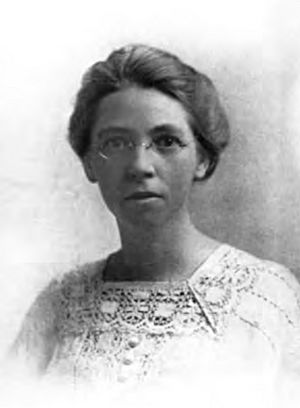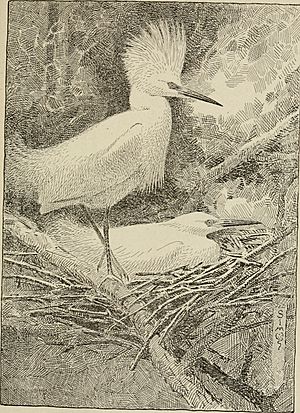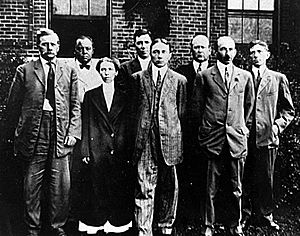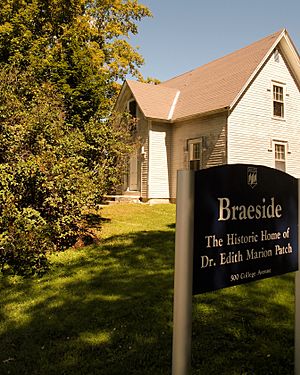Edith Marion Patch facts for kids
Quick facts for kids
Edith Marion Patch
|
|
|---|---|
 |
|
| Born | 27 July 1876 Worcester, Massachusetts, USA
|
| Died | 28 September 1954 (aged 78) Old Town, Maine, USA
|
| Education | University of Minnesota University of Maine |
| Alma mater | Cornell University |
| Known for | First Female President of the Entomological Society of America. Study of aphids. |
Edith Marion Patch (born July 27, 1876 – died September 28, 1954) was an American entomologist and writer. An entomologist is a scientist who studies insects. Edith was born in Worcester, Massachusetts. She earned her degree from the University of Minnesota in 1901.
She first worked as an English teacher. Later, she got a chance to start an entomology department at the University of Maine. In 1904, she became the head of this department. She stayed in this role until she retired in 1937. Many male colleagues were unsure about a woman leading a department. However, Edith Patch proved them wrong. She is known as the first truly successful professional woman entomologist in the United States.
Patch earned her master's degree from the University of Maine in 1910. She then got her Ph.D. from Cornell University in Ithaca, New York in 1911. During her career, she became a top expert on aphids. Aphids are tiny insects that can harm plants. She published an important book called Food Plant Catalogue of the Aphids in 1938. She was also elected president of the American Nature Study Society. In 1930, she made history as the first female president of the Entomological Society of America. Her home in Old Town, Maine, called the Edith Marion Patch House, was added to the National Register of Historic Places in 2001.
Contents
Edith Patch's Early Life and Education
Edith Marion Patch was the youngest of six children. Her parents were William Whipple Patch Jr. and Salome Jenks. After the American Civil War, her family moved to New Vinton, Iowa. They returned to Worcester, Massachusetts, in 1872. Edith showed an interest in nature from a very young age. She loved exploring near her home. She would study the animals, flowers, and plants she found.
In 1881, when she was eight, her family moved to Minneapolis, Minnesota. Two years later, they moved to the countryside. This allowed her to continue her nature studies. While still in school, she wrote an essay about the monarch butterfly. It won her a prize in a competition. She used her $25 prize money to buy a book. It was "Manual for the Study of Insects" by John Henry Comstock. The book had illustrations by Anna Botsford Comstock.
After finishing South High School in 1896, Patch went to the University of Minnesota. She graduated with a science degree in 1901. At first, she couldn't find a job as an entomologist. So, she taught English at a high school for two years. Then, Dr. Charles D. Woods offered her an unpaid job. It was at the University of Maine in the Maine Agricultural Experiment Station. Her task was to start an entomology department. Dr. Woods chose her based on her skills, not her gender. This decision was proven right. The next year, she was given a full-time job.
Edith Patch's Career and Research
Edith Patch always focused on how entomology could be useful in real life. She wrote reports about pests that harmed farm crops, garden plants, and forest trees in Maine. Her special area of study was the aphid family. Aphids have complicated life cycles. They can also spread viruses to plants. She may have chosen aphids because she worked with Professor Oestlund, an aphid expert, in Minnesota.
She stayed at the University of Maine throughout her career. She earned her master's degree in 1911. A year later, she got her doctorate from Cornell University. While at Cornell, she became friends with the Comstock family. She published about eighty scientific papers on aphids. These papers covered how to identify them, their biology, and their role in the environment.
Patch made an important discovery about the melon aphid. She found that its eggs spent the winter on a weed called Sedum purpureum. By removing this weed from nearby crops, farmers could reduce aphid problems the next year. In 1938, she published a major book. It was called "Food Plant Catalogue of the Aphids". This book listed all her discoveries about which plants different aphid species used as hosts.
Public Outreach and Environmental Views
Edith Patch also wrote articles for the "Maine Agricultural Experiment Station Bulletin". She wrote for the public too, in garden magazines and magazines like Atlantic Monthly Magazine. She also contributed to the Maine Naturalist and the Scientific Monthly Magazine. She understood how helpful good insects could be in controlling pests. She did not approve of using too many pesticides. Her ideas were similar to those of Rachel Carson. Carson wrote "Silent Spring" forty years later, warning about pesticides.
Patch collected many aphids. This collection is now part of the Canadian National Collection in Ottawa. It includes both winged and wingless forms of each species. Researchers have used it widely. She was considered a world expert on aphids. Two genera, five species, and one subspecies of aphids were named in her honor. She herself named many new species.
In 1924, Patch became the first woman to lead the Maine Agricultural Experiment Station. In 1926, she joined the Committee of Nomenclature. This committee was for the American Association of Economic Entomologists. This group later became the Entomological Society of America.
Leadership in Scientific Societies
Patch was elected president of the American Nature Study Society in 1930. In the same year, she also became the first female president of the Entomological Society of America. This was a time when this society was mostly men. Few women were allowed to join. Near the end of her career, the University of Maine gave her an honorary doctorate in 1937. In 1940, she was welcomed into the Sigma Delta Epsilon scientific fraternity.
Edith Patch's Writing for Children
After getting her PhD, Edith Patch started writing books and articles for children. These writings were about natural history. Her goal was to make kids interested in the natural world. She first published her books through her own company, Pine Cone Publishing Company in Orono.
In 1913, Patch published Dame Bug and her Babies. This book had 18 stories about insect mothers and their young. Writing this book made Patch want to keep teaching young people about nature. Another book, Little Gateways to Science, told the stories of 12 birds. It also showed how human actions can affect nature.
Later, she became well-known for her children's nature books. A bigger publisher, Macmillan Publishers, started publishing her work. With them, she created the "Holiday Series". These books were about wildlife and plants in different places. The "Neighbor Series" gave information about wild animals in their natural homes. She also wrote the "Science Readers" for schools. These books covered science topics for children up to eighth grade.
The Historic Patch House
In 1913, Edith Patch bought an old farmhouse. It had fifty acres of land in Old Town, Maine. She lived there for the rest of her life. She named the house "Braeside." This name comes from a Scottish word meaning "bank," referring to its location by the Stillwater River. Later, it became known as the "Patch House."
The house was built in the 1840s. The property included 50 acres of wild garden. This garden was home to many insects. Patch spent most of her free time there, studying and writing about nature. After she died, the University of Maine owned the house. It was used for student housing.
By the 1990s, the house was in poor condition. It was going to be torn down. An agreement was made to let firefighters burn it for training. But in 1997, just days before it was to be burned, activists saved it. They managed to get it added to Maine's list of most endangered properties. In 2001, it was added to the National Register of Historic Places.




